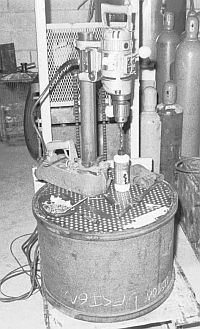|
Drilling The Water And Steam Pipe Connections Around the circumference of the bottom flue sheet are four 1/4” iron pipe connections for blowing down the boiler as well as draining it. A fifth connection, with a 3” stand pipe above the bottom flue sheet provides a means to check and insure at least 3” of water is in the boiler before the burner is ignited. While the four blow-down connections all terminate with valves, two of the blow-downs also provide connection of the water automatic and boiler water level indicator. Each pipe fitting hole had to be drilled and then tapped with a pipe tap. The blow-down connections were drilled and tapped at 90-degrees separation using a magnetic-base drill. As the boiler generates steam, only the water is turned into steam. Any minerals and other sediment or materials in the water is not converted to steam and thus remains behind in the water still in the boiler. As one drives the car and continually adds water to the boiler for conversion into steam the concentrate of minerals and other sediments increases in the water remaining in the boiler. As the Model 735 is a condensing car, the steam leaving the engine also contains steam cylinder oil. This oil will collect in the water of the boiler and also must be blown from the boiler at the end of the day’s activities. Blowing down of the boiler is the final activity before leaving a steam car to cool after a day’s drive and is intended to remove all the sediment and minerals that may remain after the day’s activities. Blowing down consists of opening valves around the lower circumference of the boiler and allowing the water in the boiler to be blown out of the boiler using the pressure of the steam in the boiler. As the water exits the blow-down valve the rapid reduction to atmospheric pressure from 600 PSIG in the boiler flashes the water to steam carrying the minerals, sediment, and any residual steam cylinder oil with it. |
